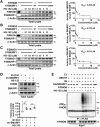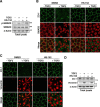A cell-based high-throughput screening method based on a ubiquitin-reference technique for identifying modulators of E3 ligases
- PMID: 30587574
- PMCID: PMC6393603
- DOI: 10.1074/jbc.RA118.003822
A cell-based high-throughput screening method based on a ubiquitin-reference technique for identifying modulators of E3 ligases
Abstract
Accumulating evidence indicates that a wide range of E3 ubiquitin ligases are involved in the development of many human diseases. Searching for small-molecule modulators of these E3 ubiquitin ligases is emerging as a promising drug discovery strategy. Here, we report the development of a cell-based high-throughput screening method to identify modulators of E3 ubiquitin ligases by integrating the ubiquitin-reference technique (URT), based on a fusion protein of ubiquitin located between a protein of interest and a reference protein moiety, with a Dual-Luciferase system. Using this method, we screened for small-molecule modulators of SMAD ubiquitin regulatory factor 1 (SMURF1), which belongs to the NEDD4 family of E3 ubiquitin ligases and is an attractive therapeutic target because of its roles in tumorigenesis. Using RAS homolog family member B (RHOB) as a SMURF1 substrate in this screen, we identified a potent SMURF1 inhibitor and confirmed that it also blocks SMURF1-dependent degradation of SMAD family member 1 (SMAD1) and RHOA. An in vitro auto-ubiquitination assay indicated that this compound inhibits both SMURF1 and SMURF2 activities, indicating that it may be an antagonist of the catalytic activity of the HECT domain in SMURF1/2. Moreover, cell functional assays revealed that this compound effectively inhibits protrusive activity in HEK293T cells and blocks transforming growth factor β (TGFβ)-induced epithelial-mesenchymal transition (EMT) in MDCK cells, similar to the effects on these processes caused by SMURF1 loss. In summary, the screening approach presented here may have great practical potential for identifying modulators of E3 ubiquitin ligases.
Keywords: high-throughput screening (HTS); E3 ubiquitin ligase; ubiquitylation (ubiquitination); inhibitor; cellular regulation; protein degradation; epithelial-mesenchymal transition (EMT); auto-ubiquitination; chemical screen; HECT domain; SMAD ubiquitin regulatory factor 1 (SMURF1); ubiquitin-reference technique (URT).
© 2019 Tian et al.
Conflict of interest statement
The authors declare that they have no conflicts of interest with the contents of this article
Figures







Similar articles
-
Smurf2 induces ubiquitin-dependent degradation of Smurf1 to prevent migration of breast cancer cells.J Biol Chem. 2008 Dec 19;283(51):35660-7. doi: 10.1074/jbc.M710496200. Epub 2008 Oct 16. J Biol Chem. 2008. PMID: 18927080
-
Deubiquitinase FAM/USP9X interacts with the E3 ubiquitin ligase SMURF1 protein and protects it from ligase activity-dependent self-degradation.J Biol Chem. 2013 Feb 1;288(5):2976-85. doi: 10.1074/jbc.M112.430066. Epub 2012 Nov 26. J Biol Chem. 2013. PMID: 23184937 Free PMC article.
-
Identification of substrates of SMURF1 ubiquitin ligase activity utilizing protein microarrays.Assay Drug Dev Technol. 2010 Aug;8(4):471-87. doi: 10.1089/adt.2009.0264. Assay Drug Dev Technol. 2010. PMID: 20804422
-
Regulation of TGF-beta family signaling by E3 ubiquitin ligases.Cancer Sci. 2008 Nov;99(11):2107-12. doi: 10.1111/j.1349-7006.2008.00925.x. Epub 2008 Sep 18. Cancer Sci. 2008. PMID: 18808420 Free PMC article. Review.
-
E3 Ubiquitin Ligases as Molecular Targets in Human Oral Cancers.Curr Cancer Drug Targets. 2016;16(2):130-5. doi: 10.2174/1568009616666151112122336. Curr Cancer Drug Targets. 2016. PMID: 26560119 Review.
Cited by
-
Targeting the ubiquitin system by fragment-based drug discovery.Front Mol Biosci. 2022 Sep 27;9:1019636. doi: 10.3389/fmolb.2022.1019636. eCollection 2022. Front Mol Biosci. 2022. PMID: 36275626 Free PMC article. Review.
-
Small molecules that target the ubiquitin system.Biochem Soc Trans. 2020 Apr 29;48(2):479-497. doi: 10.1042/BST20190535. Biochem Soc Trans. 2020. PMID: 32196552 Free PMC article. Review.
-
E3 Ubiquitin Ligases: Key Regulators of TGFβ Signaling in Cancer Progression.Int J Mol Sci. 2021 Jan 6;22(2):476. doi: 10.3390/ijms22020476. Int J Mol Sci. 2021. PMID: 33418880 Free PMC article. Review.
-
NEDD4 E3 Ligases: Functions and Mechanisms in Bone and Tooth.Int J Mol Sci. 2022 Sep 1;23(17):9937. doi: 10.3390/ijms23179937. Int J Mol Sci. 2022. PMID: 36077334 Free PMC article. Review.
-
The role of E3 ubiquitin ligase HECTD3 in cancer and beyond.Cell Mol Life Sci. 2020 Apr;77(8):1483-1495. doi: 10.1007/s00018-019-03339-3. Epub 2019 Oct 21. Cell Mol Life Sci. 2020. PMID: 31637449 Free PMC article. Review.
References
Publication types
MeSH terms
Substances
LinkOut - more resources
Full Text Sources
Other Literature Sources

